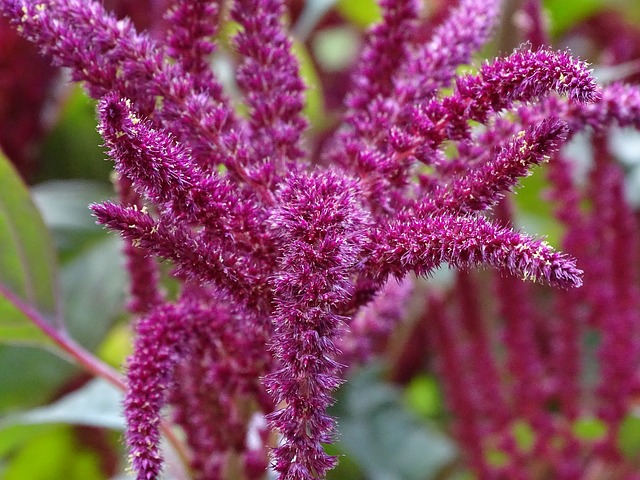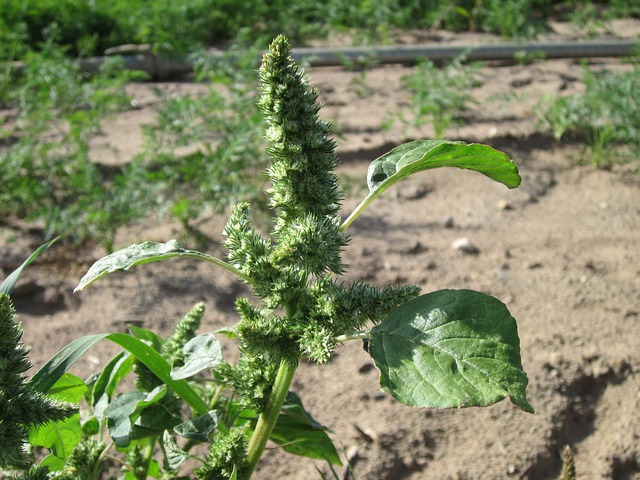  |   |  |   |  |
 |  |
Amaranths are mostly annual or perennial herbaceous plants, typically growing to heights of 15 to 80 centimeters. The entire plant may be green or purplish-red in color. Some species, such as Amaranthus retroflexus (redroot amaranth), develop root tubers.
The leaves are alternate, simple, without stipules, and range in shape from rhombic to lanceolate or ovate. The leaf blade tapers at the base into a petiole, with a notched tip and a small point. Upper leaves have very short petioles, while the lower leaves have long petioles. The short petioles of the upper leaves do not shade the lower leaves because they grow until the leaf blade emerges from the shadow of the upper leaves.
The flowers are small, usually actinomorphic (radially symmetrical), apetalous, and hidden among sharp green bracts. They are bisexual. Both monoecious and dioecious species occur. Axillary flowers are grouped in small clusters, while terminal flowers form dense spike-like panicles. The calyx consists of five (sometimes 1–4) usually dry and membranous sepals or may be absent. There are five stamens, and the gynoecium is composed of 2–3 (sometimes 4) carpels.
The floral formula is: K5 C0 A5 G(2–3).
Harvesting of Raw Materials
The fruit is typically a nutlet, less commonly a capsule. Seeds are numerous, quite small, smooth, and enclosed in a tough coat well adapted for dispersal by falling from the fruit (a phenomenon known as barochory) and spreading with soil. Each healthy plant can produce hundreds of thousands of seeds.
Amaranth raw material is harvested using various methods. The plant is typically collected at the end of summer, after flowering has finished, to ensure adequate maturity. However, some species require harvesting in winter.
At home, seeds must be extracted manually from the seed capsules, whereas in industrial settings, harvesting is done with a combine harvester. Amaranth flowers and stems are either frozen, dried, or fermented similarly to traditional cabbage fermentation.
For drying, the plant is cut into small pieces and spread in a thin layer in a well-ventilated area, occasionally stirred. Alternatively, amaranth leaves are gathered into small bundles, hung, and dried; when the plant crumbles easily, it is sufficiently dried. To preserve a larger amount of beneficial compounds, the plant may be cut into pieces and stored in the refrigerator.
Dried raw material is kept in a dry, dark, and ventilated space, preferably hung to maintain quality. For freezing, amaranth bundles are washed, dried, placed in bags, and stored in the freezer. Frozen plant parts are best used within one year to avoid loss of beneficial properties.
Marinating is done in two ways: the first involves preparing a brine made of salt and sugar, while the second (dry) method consists of simply covering the bundles with salt and packing them into containers.
Chemical Composition
Today, amaranth is considered a treasure trove of health benefits due to its rich content of valuable nutrients.
Amaranth contains a record-high amount of protein (16–18%) and approximately 10% of the anti-tumor compound squalene. It is also rich in essential amino acids—particularly lysine, which is present in amounts 30 times greater than in common cereal grains. Additionally, amaranth contains polyunsaturated fatty acids such as oleic, linoleic, and linolenic acids.
The plant is a good source of dietary fiber (14%), protein (18%), sugars (18%), fats (5–6%), starch (55–62%), and pectins. Amaranth is also abundant in minerals including iron, phosphorus, potassium, calcium, and magnesium. High levels of vitamin E, B-complex vitamins, bile acids, phospholipids, steroids, and phytosterols have been documented.
Leaves and stems of amaranth contain 18 different sterols. The leaves also provide vitamins C and E, carbohydrates, and flavonoids such as quercetin, trifolin, and rutin. Compared to most cereal crops, amaranth seeds surpass in protein content, organic compounds, oil, fiber, and especially in the amino acid lysine.
Pharmacological Properties
The omega-6 polyunsaturated fatty acids found in amaranth positively influence cholesterol metabolism and help prevent the development of atherosclerosis. Vitamin E, a powerful antioxidant, slows aging, prevents cardiovascular diseases, reduces the formation of blood clots and cholesterol plaques, and strengthens the myocardium.
Squalene enhances the body's resistance (immunity) to various diseases, protects cells from radiation and malignant transformation, shields the skin from harmful substances, and helps prevent the development of skin cancers. It also maintains skin hydration, slows skin aging, and promotes oxygen saturation throughout the body.
Provitamin A, vitamins E and D, polyunsaturated fatty acids, and other compounds in amaranth oil slow the process of premature skin aging and contribute to skin rejuvenation. Amaranth is considered an ideal remedy for restoring the body after chemotherapy.
Use in Traditional Medicine
Amaranth has been used since ancient times to treat a variety of ailments. In traditional medicine, it is valued as a source of numerous healing compounds and is employed for heart diseases, gastrointestinal infections, eczema, psoriasis, dermatitis, erosions, endometriosis, colitis, and externally for fungal infections.
Amaranth infusion is used to treat kidney and liver diseases, as well as enuresis and inflammations of the genitourinary system. Juice from fresh amaranth leaves is consumed for stomach pain, gastritis, and diabetes mellitus. Tinctures made from dried amaranth seeds and leaves are used to prevent flu and common colds.
Amaranth baths are taken to treat skin diseases, allergies, diathesis, and rashes. Oil extracted from amaranth seeds is applied for burns, pressure sores, insect bites, and scars. Sprouted amaranth seeds are used in the treatment of oncological diseases.
Both juice and tincture of amaranth can be used as anti-tumor agents, internally and externally. Decoctions of amaranth roots are taken against guinea worm disease and jaundice. Root and seed decoctions are also used to treat dysentery.
For inflammations of the oral mucosa, amaranth juice diluted in a 1:5 ratio is used as a mouth rinse. For rejuvenation and detoxification, an herbal blend of amaranth, St. John’s wort, birch buds, and chamomile in equal parts is consumed.
In Chinese medicine, amaranth is used to combat tumors and slow down the aging process.
Amaranthus retroflexus L.

